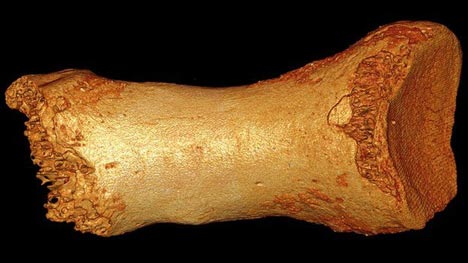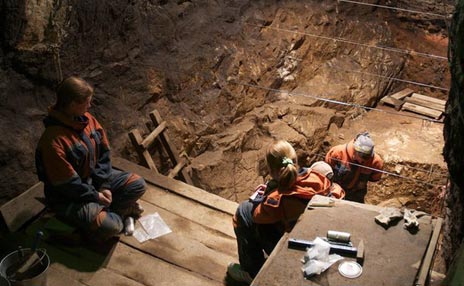Denisovan Cave Material Hints at New Mystery Human Species
Research Shows that Neanderthals and Denisovans were Closely Related
Scientists from the Max Planck Institute for Evolutionary Anthropology based in Leipzig (Germany) have completed an analysis of ancient hominin DNA from a cave located in the Altai Mountains of Siberia. Their study suggests the existence of a mystery human species, as evidence from the genome indicates the likelihood of extensive interbreeding and the possible recording of genetic material from Homo erectus. H. erectus, although very different from modern humans, is much more “modern looking” than earlier hominins. It also has the distinction of being the longest living species in terms of the age of its fossil record.
Homo erectus
The earliest fossil material ascribed to H. erectus is approximately 1.9 million years old, yet H. erectus may have survived until just fifty thousand years ago. Fossils are known from Europe and Asia, but it is likely this species evolved in Africa. It is the oldest globally distributed species of hominin known.
The research team have also announced that they have completed the most detailed analysis of a Neanderthal’s DNA to date. The details of the team’s work has been published in the scientific journal “Nature”. Back in 2010, Everything Dinosaur team members reported on the discovery of a new hominin species after researchers found fragmentary fossil remains in a cave located in the Altai Mountains. The cave known as the Denisova Cave, gave rise to the name of this new species, they were labelled Denisovans, a type of human distinct from both Neanderthals and H. sapiens that lived in that part of Siberia forty thousand years ago.
To read the article on the discovery of the Denisovans: Evidence of New Species of Early Human Found.
Neanderthal Toe Bone
This new research concerns a Neanderthal (Homo neanderthalensis) toe bone that was found in the same cave as the Denisovan discovery, although it comes from a layer of sediments believed to date from between 50,000 and 60,000 years ago. The Denisova site has provided evidence of Denisovans, Neanderthals and modern humans, this location seems to have been home to at least three species of early humans over the years – although each species occupied the cave at different times in prehistory.
The Neanderthal Toe Bone Used in the Study
Picture credit: Bence Viola
Professor Svante Paabo (Max Planck Institute) led the analysis of the toe bone and it has revealed some interesting information about both Neanderthals and other early human types. The toe bone came from a female Neanderthal, one that was highly inbred perhaps the child of half-siblings who shared the same mother. Other family relationship scenarios are possible however, including that her parents were an uncle/niece or aunt/nephew combination. It is also feasible from the DNA study that her parents were a grandparent and grandchild or double first-cousins (the children of two siblings who bred with siblings).
Whatever the exact family relationship, based on this evidence, even the most ardent soap script writers would do well to come up with a convoluted story line to explain this one away.
Denisovan Cave Material
The research into the toe bone when compared to data on the Denisovans suggest that Neanderthals and Denisovans were closely related and probably looked very similar to each other as species. Based on this study, it indicates that the Neanderthal/Denisovan common ancestor split off from the branch of the human family tree that would eventually lead to our own species, around 400,000 years ago. The genome study as revealed by the Max Planck Institute also indicates that the Neanderthals and the Denisovans themselves diverged from each other around 300,000 years ago.
In addition, this genetic analysis threw up a surprise result. It has been postulated that the Denisovans interbred with a mystery, fourth type of early hominin that was living in Eurasia. Between 2.7 and 5.8% of the Denisovan genome comes from this, as yet not identified species.
This group split from the others more than a million years ago, and may represent the early human species known as Homo erectus, which fossils show was living in Europe and Asia a million or more years ago.
But Spanish researchers also recognise a species known as Homo antecessor, whose fossils show up about a million years ago at the Atapuerca site, near Burgos in Spain, and this may be another candidate.
Though Denisovans and Neanderthals eventually died out, they left behind bits of their genetic heritage because they occasionally interbred with modern humans. The research team estimates that between 1.5 and 2.1 percent of the genomes of modern non-Africans can be traced to Neanderthals, whilst perhaps as much as 0.8% (on average across the entire human genome), of modern human DNA can be traced back to the Denisovan lineage, although most Denisovan DNA traces are associated with those modern humans from Oceanic or Asian populations.
Excavations in the Denisova Cave System Indicate at Least Three Species of Hominin Have Inhabited It
Picture credit: Bence Viola
The study proposes that as much 6% of the genomes of Aboriginal Australians, natives of New Guinea and some Pacific Islanders can be traced to Denisovans. The new analysis finds that the genomes of Han Chinese and other mainland Asian populations, as well as of Native Americans, contain about 0.2% Denisovan genes.
Interbreeding between populations has certainly “clouded” the genetic map of modern humans and it is difficult to distinguish links to different species as a result, but the research has also identified at least eighty-seven specific genes to H. sapiens that are significantly different to Denisovan and Neanderthal DNA. The research team suggest that these genes may hold clues to behavioural differences between different types of early human and may even go some way to explaining why we are still here but the Neanderthals and Denisovans as species are extinct.



